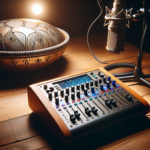<!DOCTYPE html>
<html lang="en">
<head>
<meta charset="UTF-8">
<meta name="viewport" content="width=device-width, initial-scale=1.0">
<title>Fusion Handpan Music</title>
</head>
<body>
<article>
<header>
<h1>The Mesmerizing Melodies: Exploring Fusion Handpan Music</h1>
</header>
<section>
<p>In the vast world of musical instruments, the handpan has emerged as a compelling and relatively new discovery. Its enchanting melodies have the power to soothe the soul and captivate audiences. Originating in Switzerland in the early 2000s, the handpan has journeyed from being a niche curiosity to achieving widespread acclaim among musicians and listeners alike. Fusion handpan music specifically combines the calming, ethereal vibes of the handpan with various other musical genres, creating a mesmerizing new soundscape.</p>
<h2>The Origins of the Handpan</h2>
<p>The handpan, often referred to as a "hang" (from the German word for hand), was invented by Felix Rohner and Sabina Schärer of PanArt. It was inspired by the steelpan, a percussive instrument from Trinidad and Tobago, and shares its convex shape. What sets the handpan apart is its unique construction and the sonic capabilities it offers. Unlike the steelpan, the handpan is played with the hands rather than mallets, giving it a softer and more resonant sound.</p>
<h2>The Anatomy of the Handpan</h2>
<p>A handpan is typically fashioned from two metal hemispheres fused together, creating a UFO-like shape. The top side, or Ding side, features a central note area surrounded by several tone fields, each tuned to a specific pitch. The bottom side, or Gu side, usually has a central hole which aids in acoustic resonance. The instrument's unique sound is a result of the careful hammering and tuning of these tone fields, leading to its distinctive melodic and percussive qualities.</p>
<h2>Fusion Handpan Music: A New Musical Genre</h2>
<p>Fusion handpan music represents a genre where the handpan intersects with other musical styles, creating inherently hybrid compositions. Musicians worldwide are experimenting with blending the handpan’s ethereal tones with jazz, electronic music, classical landscapes, and even traditional world music.</p>
<h2>Integrating Handpan with Electronic Music</h2>
<p>One of the most celebrated examples of fusion handpan music can be found in the realm of electronic music. Combining the handpan with electronic beats and synthesizers can result in hypnotic soundscapes. Artists like <strong>Mose</strong> and <strong>Kabeção</strong> are leading the way in this space, creating tracks that are perfect for relaxation, meditation, and mindfulness exercises.</p>
<h2>Jazz and the Handpan: A Match Made in Heaven</h2>
<p>The rhythmic complexity and melodic depth of the handpan make it an ideal companion for jazz. Incorporating the handpan into jazz ensembles adds a whole new layer of texture and improvisation potential. Handpan virtuosos like <strong>Ravid Goldschmidt</strong> and <strong>Manu Delago</strong> have shown how seamlessly the instrument fits into the intricate and soulful world of jazz.</p>
<h2>Classical Collaborations</h2>
<p>While it might seem an unconventional pairing at first, the handpan's warm, resonant sound can beautifully complement classical instruments like the piano, violin, and cello. Composers and musicians are beginning to explore this synergy, crafting compositions that harness the meditative qualities of the handpan alongside the emotive power of classical music.</p>
<h2>World Music Influence</h2>
<p>Given its global roots, the handpan is naturally at home within world music settings. Its versatile tones can blend wonderfully with traditional instruments from various cultures, including Indian sitars, African djembes, and Middle Eastern ouds. This fusion not only respects and includes the handpan's origins but also enriches it with diverse sonic elements.</p>
<h2>The Future of Fusion Handpan Music</h2>
<p>As more musicians discover the handpan and its endless creative possibilities, the future of fusion handpan music looks incredibly bright. Online platforms and social media have allowed handpan musicians to reach global audiences, fostering a supportive and collaborative international community. New technological innovations, such as electronically enhanced handpans, are also expanding the instrument's capabilities, allowing artists to push the boundaries of what’s possible.</p>
<h2>How to Get Started with Handpan Music</h2>
<p>For aspiring handpan musicians, there are a few key steps to get started. Selecting the right handpan is crucial as each instrument varies in scale, tuning, and quality. Beginners should consider starting with a reputable brand to ensure they receive a well-crafted instrument.</p>
<p>Learning to play the handpan involves developing a sense of rhythm and melody simultaneously. Many online tutorials and instructional videos are available, making it easier than ever to begin. Local handpan communities and workshops can also offer valuable hands-on experience and support.</p>
<h2>Live Performances and Recordings</h2>
<p>Experiencing fusion handpan music live is a truly immersive experience. The captivating visuals of the instrument being played combined with the ambient soundscapes can transport listeners to a different realm. Recordings and live-streamed performances on platforms like YouTube and Spotify provide an accessible way for audiences to enjoy and support fusion handpan artists.</p>
</section>
<footer>
<h2>Conclusion</h2>
<p>Fusion handpan music is an exciting and evolving genre that highlights the versatility and emotional depth of this remarkable instrument. By blending the handpan's unique sound with various musical styles, artists are crafting innovative and captivating sonicscapes. Whether in jazz, electronic, classical, or world music contexts, the fusion of the handpan continues to enthrall and inspire. As the genre grows, it invites more musicians and listeners to explore and appreciate its mesmeric melodies.</p>
<h2>FAQs</h2>
<h3>1. What is a handpan?</h3>
<p>A handpan is a convex steel drum played with the hands, known for its unique, harmonious sounds. It originated in Switzerland around the early 2000s.</p>
<h3>2. What makes fusion handpan music unique?</h3>
<p>Fusion handpan music combines the ethereal tones of the handpan with other musical genres, such as jazz, electronic, classical, and world music, creating innovative and hybrid soundscapes.</p>
<h3>3. Can beginners learn to play the handpan?</h3>
<p>Yes, beginners can learn to play the handpan. There are many online tutorials, instructional videos, and community workshops that offer resources and support for new players.</p>
<h3>4. Who are some notable fusion handpan artists?</h3>
<p>Some notable fusion handpan artists include Mose, Kabeção, Ravid Goldschmidt, and Manu Delago, who have made significant contributions to blending the handpan with various musical styles.</p>
<h3>5. How can I experience live fusion handpan music?</h3>
<p>You can experience live fusion handpan music through concerts, festivals, and live-streamed performances on platforms like YouTube and Spotify. These experiences can provide an immersive and interactive way to enjoy the music.</p>
</footer>
</article>
</body>
</html>The Mesmerizing Melodies: Exploring Fusion Handpan Music

Leave a comment




